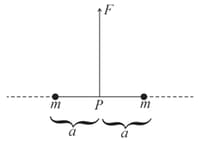What is electrical repulsion?
Important Questions on Electrostatics
As shown in the figure, two particles, each of mass tied at the ends of a light string of length are kept on a frictionless horizontal surface. When the mid point of the string is pulled vertically upwards with a small but constant force the particles move towards each other on the surface. Magnitude of acceleration of each particle, when the separation between them becomes is

When a soap bubble is charged, its size
If and are the accelerations due to gravity on the surfaces of the Earth and the Moon respectively and if Millikan's oil drop experiment could be performed on the two surfaces, one will find the ratio to be
Represent the union of two sets by Venn diagram for each of the following.
is a prime number between and
is an odd number between and

